Feline CCL5/RANTES Antibody
R&D Systems, part of Bio-Techne | Catalog # AF3819


Key Product Details
Species Reactivity
Feline
Applications
ELISA Capture (Matched Antibody Pair), Neutralization, Western Blot
Label
Unconjugated
Antibody Source
Polyclonal Sheep IgG
Product Specifications
Immunogen
E. coli-derived recombinant feline CCL5/RANTES
Tyr26-Asn92 (Lys84Tyr and Gly85 del)
Accession # Q8SQ40
Tyr26-Asn92 (Lys84Tyr and Gly85 del)
Accession # Q8SQ40
Specificity
Detects feline CCL5/RANTES in ELISAs and Western blots. In sandwich immunoassays, less than 0.02% cross-reactivity with recombinant human RANTES, recombinant mouse RANTES, and recombinant cotton rat RANTES is observed.
Clonality
Polyclonal
Host
Sheep
Isotype
IgG
Endotoxin Level
<0.10 EU per 1 μg of the antibody by the LAL method.
Scientific Data Images for Feline CCL5/RANTES Antibody
Chemotaxis Induced by CCL5/RANTES and Neutral-ization by Feline CCL5/ RANTES Antibody.
Recombinant Feline CCL5/ RANTES (Catalog # 3819-FR) chemoattracts the BaF3 mouse pro-B cell line transfected with human CCR5 in a dose-dependent manner (orange line). The amount of cells that migrated through to the lower chemotaxis chamber was measured by Resazurin (Catalog # AR002). Chemotaxis elicited by Recombinant Feline CCL5/ RANTES (80 ng/mL) is neutral-ized (green line) by increasing concen-trations of Sheep Anti-Feline CCL5/RANTES Antigen Affinity-purified Polyclonal Antibody (Catalog # AF3819). The ND50 is typically 0.5-2.5 µg/mL.Applications for Feline CCL5/RANTES Antibody
Application
Recommended Usage
Western Blot
0.1 µg/mL
Sample: Recombinant Feline CCL5/RANTES (Catalog # 3819-FR)
Sample: Recombinant Feline CCL5/RANTES (Catalog # 3819-FR)
Neutralization
Measured by its ability to neutralize CCL5/RANTES-induced chemotaxis in the BaF3 mouse pro-B cell line transfected with human CCR5. The Neutralization Dose (ND50) is typically 0.5-2.5 µg/mL in the presence of 80 ng/mL Recombinant Feline CCL5/RANTES.
Feline CCL5/RANTES Sandwich Immunoassay
Please Note: Optimal dilutions of this antibody should be experimentally determined.
Formulation, Preparation, and Storage
Purification
Antigen Affinity-purified
Reconstitution
Reconstitute at 0.2 mg/mL in sterile PBS. For liquid material, refer to CoA for concentration.
Formulation
Lyophilized from a 0.2 μm filtered solution in PBS with Trehalose. *Small pack size (SP) is supplied either lyophilized or as a 0.2 µm filtered solution in PBS.
Shipping
Lyophilized product is shipped at ambient temperature. Liquid small pack size (-SP) is shipped with polar packs. Upon receipt, store immediately at the temperature recommended below.
Stability & Storage
Use a manual defrost freezer and avoid repeated freeze-thaw cycles.
- 12 months from date of receipt, -20 to -70 °C as supplied.
- 1 month, 2 to 8 °C under sterile conditions after reconstitution.
- 6 months, -20 to -70 °C under sterile conditions after reconstitution.
Background: CCL5/RANTES
References
- Schall, T.J. et al. (1990) Nature 347:669.
- Bacon, K.B. et al. (1995) Science 269:1727.
- Fischer, F.R. et al. (2001) J. Immunol. 167:1637.
- Schall, T.J. et al. (1992) Eur. J. Immunol. 22:1477.
- Kimura, T. et al. (2003) Vet. Dermatol. 14:269.
- Appay, V. and S.L. Rowland-Jones (2001) Trends Immunol. 22:83.
- Levy, J.A. (2009) J. Immunol. 182:3945.
- Randolph-Habecker, J.R. et al. (2002) Cytokine 19:37.
- DeVico, A.L. and Gallo, R.C. (2004) Nat. Rev. Microbiol. 2:401.
- Proost, P. et al. (1998) J. Biol. Chem. 273:7222.
- Appay, V. et al. (1999) J. Biol. Chem. 274:27505.
- Proudfoot, A.E.I. et al. (2003) Proc. Natl. Acad. Sci. 100:1885.
- von Hundelshausen, P. et al. (2005) Blood 105:924.
- von Hundelshausen, P. et al. (2001) Circulation 103:1772.
- Zernecke, A. et al. (2008) Arterioscler. Thromb. Vasc. Biol. 28:1897.
- Baltus, T. et al. (2003) Blood 102:1985.
- Soria, G. and A. Ben-Baruch (2008) Cancer Lett. 267:271.
Alternate Names
RANTES, SISd
Gene Symbol
CCL5
UniProt
Additional CCL5/RANTES Products
Product Documents for Feline CCL5/RANTES Antibody
Product Specific Notices for Feline CCL5/RANTES Antibody
For research use only
